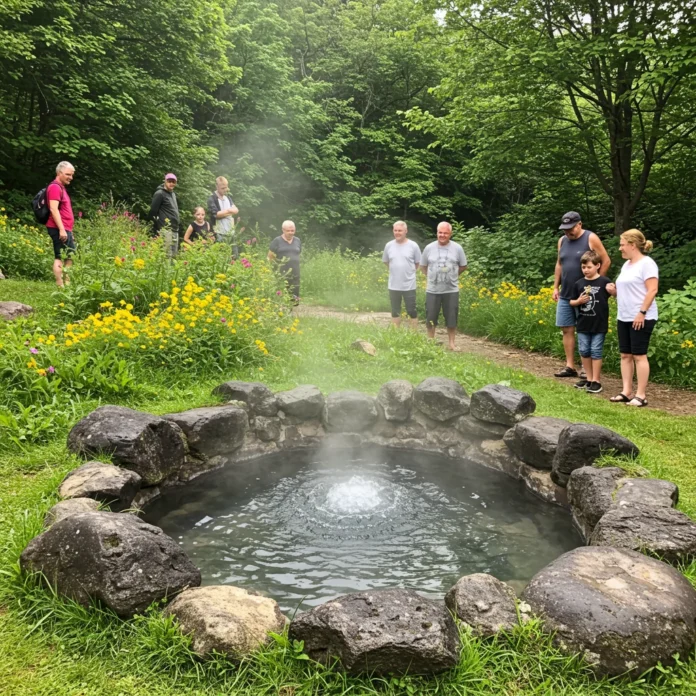Introduction to Bubbling Wells: Nature’s Unexpected Spa
Beneath the earth’s surface, natural forces quietly shape extraordinary wonders. Among these, bubbling wells stand out for their immersive beauty and surprising therapeutic qualities. These geological marvels, where water effervesces with mineral-rich bubbles, have attracted curious travelers and wellness seekers for centuries. The sensation of warm vapor rising and the gentle sound of water gurgling create a setting that feels both ancient and rejuvenating—a true gift from nature’s hidden depths.
In this article, we’ll guide you through the science, culture, and adventure that surround these “unexpected spas,” offering insights for your own visit and practical tips to make the most of your experience.
What Are Bubbling Wells?
When we speak of bubbling wells, we refer to natural springs where gases, often carbon dioxide or methane, escape through underground water, creating a mesmerizing display of bubbles at the surface. Unlike ordinary wells, these sites are dynamic, constantly shifting as geothermal energy and subterranean chemistry interact.
The bubbling effect can range from subtle fizzing to dramatic eruptions, depending on the geological conditions. Some bubbling wells are hot, inviting bathers to relax in their warmth, while others remain refreshingly cool.
How Do Bubbling Wells Form?
The creation of a bubbling well begins deep underground, where water meets hot rocks or pockets of trapped gases. Over time, pressure builds until the water and gas escape upwards, often carrying dissolved minerals along the way. The result is a well or spring that bubbles continuously or in rhythmic pulses.
The process varies depending on local geology, but the interplay between water, heat, and gas is always at the core. This ongoing natural activity gives each bubbling well its own unique character and mineral composition.
The Science Behind Bubbling Wells
Understanding the science behind bubbling wells enhances our appreciation for their beauty and health benefits. The interaction of geology, hydrology, and chemistry creates these natural spas.
Geothermal Activity and Bubbling Wells
In regions with active geothermal activity, underground heat warms groundwater, causing it to rise rapidly. As the water approaches the surface, the pressure drops, allowing dissolved gases to escape as bubbles. This phenomenon is most visible in volcanic areas, where the earth’s crust is thin and heat is abundant.
Gas Release and Mineral Springs Explained
Not all bubbling wells are hot. Some form in areas rich in gas deposits, where cool water mixes with carbon dioxide or methane. As the gas escapes, it pushes water upward, creating the signature bubbling effect. These mineral springs often have distinct tastes and colors, influenced by the dissolved minerals they carry.
Types of Bubbling Wells Around the World
Bubbling wells are as diverse as the landscapes they inhabit. From steaming hot pools to sparkling cold springs, their variety reflects the geological richness of our planet.
Hot Springs vs. Cold Bubbling Wells: What’s the Difference?
The primary distinction lies in temperature. Hot springs are heated by geothermal energy, often reaching temperatures suitable for bathing. Their warmth soothes muscles and draws visitors year-round. In contrast, cold bubbling wells remain at ambient temperatures, offering a refreshing experience, especially in warmer climates.
Both types can be rich in minerals, though the specific composition depends on the local geology. The sensory experience—whether enveloped in mist or invigorated by cool water—sets each apart.
Famous Bubbling Wells by Continent
Across continents, certain bubbling wells have achieved legendary status for their beauty, healing properties, or unique geological features.
Asia’s Most Notable Bubbling Wells
Asia boasts a wide array of bubbling wells, with Japan’s onsen hot springs and Taiwan’s Beitou springs drawing visitors for their mineral-rich waters and restorative atmosphere. In Indonesia, Bali’s natural springs offer a tranquil alternative to crowded beaches—akin to the serenity described in our post about Tibumana Waterfall, Bali’s Quiet Paradise.
Europe’s Unique Bubbling Springs
Europe’s bubbling springs have been revered since Roman times. The spa town of Bath in England, for instance, is famous for its hot, mineral-laden waters. In Iceland, the Blue Lagoon’s steamy, silica-rich pools create an ethereal setting that attracts travelers seeking both relaxation and adventure.
North America’s Bubbling Hotspots
From Yellowstone’s geysers to California’s Calistoga springs, North America offers a spectrum of bubbling wells. The combination of geothermal activity and mineral deposits makes these locations ideal for wellness tourism. For those interested in water-based adventures, the natural pools and waterfalls of the Americas rival even the famed Tulum cenotes.
South American Bubbling Wells
South America’s volcanic backbone gives rise to bubbling wells like those in Chile’s Termas Geométricas. These springs, surrounded by lush forests and dramatic mountains, offer a multisensory escape, with the scent of minerals in the air and the sound of water echoing through the trees.
Africa’s Hidden Geothermal Gems
Africa’s bubbling wells are less known but equally captivating. Ethiopia’s Danakil Depression, for instance, features colorful, bubbling pools shaped by extreme geothermal activity. Local communities have long treasured these sites for their mystique and perceived healing powers.
Oceania’s Natural Spa Wonders
New Zealand’s Rotorua region is synonymous with bubbling mud pools and hot springs, where the earth’s energy is palpable. Australia, too, hosts mineral springs that attract wellness enthusiasts and curious travelers alike.
What Minerals Are Found in Bubbling Wells?
The mineral composition of a bubbling well is one of its defining features, influencing everything from water color to therapeutic potential.
How Do Minerals Affect Water Quality?
Minerals dissolved in bubbling well water can impart unique hues, from milky blue to rusty orange. They also affect taste and texture, with some springs leaving a silky residue on the skin. High concentrations of certain minerals can make water unsuitable for drinking, while others enhance its perceived health benefits.
Common Minerals in Bubbling Wells
The most frequently encountered minerals in bubbling wells include:
- Silica: Known for its skin-softening properties
- Sulfur: Recognized by its distinctive smell and believed to aid joint health
- Calcium and Magnesium: Often praised for their muscle-relaxing effects
- Iron: Imparts a reddish tint and can benefit blood health
Each mineral brings its own set of sensations and purported benefits, making every bubbling well a unique experience.
The Health Benefits of Bubbling Wells
For centuries, people have sought out bubbling wells for their reputed health benefits. While not all claims are scientifically proven, many visitors report tangible improvements in well-being.
Can Bubbling Wells Really Improve Well-being?
Bathing in mineral-rich, bubbling water can soothe muscles, relieve stress, and promote relaxation. The warmth of hot springs, combined with the gentle massage of rising bubbles, creates a spa-like ambiance that encourages both physical and mental restoration.
Minerals and Their Effects on the Body
Certain minerals, such as magnesium and calcium, are absorbed through the skin and may help reduce inflammation or improve circulation. Sulfur, though pungent, is traditionally associated with joint health and relief from skin conditions.
Traditional Healing Practices and Bubbling Wells
Many cultures have integrated bubbling wells into their traditional healing systems. In Japan, onsen bathing is considered a spiritual and physical ritual. In Europe, spa towns have drawn visitors seeking cures for ailments ranging from arthritis to respiratory issues.
As experts often say:
“Nature provides the best remedies—sometimes all you need is a little time in the water and a willingness to let the earth work its magic.”
Cultural Significance of Bubbling Wells
Beyond their physical effects, bubbling wells hold deep cultural meaning. They are sites of gathering, ritual, and storytelling.
Bubbling Wells in Ancient Rituals
In many ancient societies, bubbling wells were seen as portals to the spirit world or as gifts from deities. Rituals often involved offerings or prayers for health and prosperity, emphasizing the sacredness of these natural features.
Folklore and Legends Surrounding Bubbling Wells
Stories abound of miraculous healings and encounters with spirits at bubbling wells. These legends have been passed down through generations, enriching the cultural tapestry of regions blessed with these springs.
Modern-Day Uses of Bubbling Wells
Today, bubbling wells serve a variety of functions—from wellness retreats to eco-tourism destinations. Their appeal lies in the blend of natural beauty and therapeutic promise.
Bubbling Wells as Tourist Attractions
Many bubbling wells are now popular tourist sites, drawing visitors eager to experience their restorative waters. Guided tours, spa treatments, and cultural experiences are commonly available. For example, the thrill of discovering a hidden spring can be likened to the sense of adventure described in our post about hiking to Las Tinajas Waterfall.
Therapeutic Spas Built Around Bubbling Wells
Luxury spas have sprung up around some of the world’s most famous bubbling wells, offering treatments that harness the mineral-rich waters. From soaking pools to mud baths, these facilities combine traditional healing with modern comfort.
Eco-Tourism and Sustainable Travel
Increasingly, bubbling wells are being integrated into eco-tourism initiatives. Responsible operators focus on conservation, education, and community benefit, ensuring that visitors enjoy the springs while respecting their fragile ecosystems.
How to Visit a Bubbling Well Safely
Visiting a bubbling well is a memorable experience, but it’s important to prepare properly and follow safety guidelines to maximize enjoyment and minimize risk.
What Should You Bring to a Bubbling Well?
To make the most of your visit, consider packing:
- Swimsuit and quick-dry towel
- Water shoes or sandals with good grip
- Reusable water bottle (for hydration, not for collecting spring water unless permitted)
- Sun protection, including hats and mineral-based sunscreen
- A change of clothes and a waterproof bag for wet items
For those who enjoy swimming in natural settings, you may find parallels with the unique experiences described in our feature on Puerto Rico’s rainforest waterslides.
Safety Precautions for Bathers
Always check posted signs or ask local guides about water temperature, depth, and mineral content. Some springs may be too hot for safe bathing, while others could contain high levels of sulfur or arsenic.
- Test water temperature before entering
- Avoid submerging your head in unfamiliar springs
- Supervise children closely
- Respect local regulations and environmental protections
Environmental Impact of Bubbling Wells
Bubbling wells are sensitive ecosystems, shaped by millennia of geological and biological processes. Human activity can threaten their delicate balance.
Are Bubbling Wells at Risk from Human Activity?
Overuse, pollution, and careless development can degrade bubbling wells. Litter, sunscreen chemicals, and physical damage to surrounding vegetation all pose risks. Sustainable tourism practices are essential to protect these natural wonders.
Conservation Efforts for Bubbling Wells
Many local and international organizations are working to safeguard bubbling wells. Efforts include habitat restoration, water quality monitoring, and community education. Responsible tourism supports these initiatives by generating funds and raising awareness.
The Role of Bubbling Wells in Local Ecosystems
Bubbling wells often support unique ecosystems, providing habitat for rare plants and animals. The constant flow of mineral-rich water creates niches for specialized species that thrive in these environments.
Wildlife and Bubbling Wells: A Symbiotic Relationship?
The relationship between bubbling wells and local wildlife is intricate. Some species rely on the warm waters for breeding, while others benefit from the minerals and microclimates the wells create.
How Do Bubbling Wells Support Biodiversity?
By maintaining constant temperatures and nutrient flows, bubbling wells encourage the proliferation of diverse aquatic plants, insects, and amphibians. These, in turn, attract birds and mammals, making the wells hotspots of biodiversity.
Unique Flora and Fauna Around Bubbling Wells
From rare algae to endemic frogs, the flora and fauna found near bubbling wells are often highly specialized. Conservation of these sites helps protect entire webs of life that depend on these unique habitats.
Bubbling Wells in Art and Literature
The allure of bubbling wells extends beyond science and health—they have inspired artists and writers throughout history.
Depictions in Ancient Art
Ancient mosaics, pottery, and carvings frequently depict bubbling wells as symbols of fertility, renewal, or divine presence. These artistic representations reflect the reverence people held for these sites.
Modern Artistic Inspirations from Bubbling Wells
Contemporary artists draw on the visual drama and soothing ambiance of bubbling wells, using vibrant colors and dynamic forms to evoke their essence. Installations and photography projects often aim to capture the interplay of light, steam, and water.
Famous Literary References
Literature, too, is rich with references to bubbling wells. From ancient myths to modern travel writing, these springs appear as settings for transformation, healing, or revelation.
Photographing Bubbling Wells: Tips and Techniques
Capturing the magic of a bubbling well requires an understanding of light, perspective, and timing. The interplay of bubbles, steam, and reflections presents both challenges and opportunities for photographers.
Best Times and Angles for Photos
Early morning or late afternoon provides soft, golden light that enhances the ethereal quality of the springs. Shooting from a low angle can emphasize the movement of bubbles, while overhead shots reveal intricate patterns formed by minerals and water.
Recommended Equipment for Capturing Bubbling Wells
For best results, consider:
- A DSLR or mirrorless camera with a wide-angle lens
- Polarizing filters to reduce glare
- Tripod for long exposures, especially in low light
- Protective gear for your camera, as humidity and splashes are common
A waterproof camera or action cam is also useful for close-up shots, similar to techniques used for underwater photography at locations like the cenotes of Tulum.
DIY Bubbling Wells: Can You Create One at Home?
The fascination with bubbling wells often inspires the question: can you replicate this phenomenon at home? While true geothermal wells are impossible to reproduce, there are safe and educational ways to mimic the effect.
Is It Safe to Make a Bubbling Well in Your Backyard?
Creating a genuine bubbling well requires specialized geological conditions and can be hazardous. However, small-scale water features that bubble using pumps or natural gas infusion are popular in landscaping. Always consult professionals and avoid attempting to access underground gases.
Simple Science Experiments for Kids
For a hands-on learning experience, simple experiments can illustrate the principles behind bubbling wells. Mixing baking soda and vinegar in a clear container, for example, produces visible bubbles as carbon dioxide is released—an accessible demonstration of natural gas release in springs.
Famous Bubbling Wells to Add to Your Bucket List
If you are seeking memorable travel experiences, consider adding famous bubbling wells such as Iceland’s Blue Lagoon, Japan’s Beppu Onsen, and Yellowstone’s Mammoth Hot Springs to your itinerary. Each offers a unique blend of scenery, culture, and wellness.
Planning Your Bubbling Well Adventure
Careful planning enhances the enjoyment of your bubbling well journey. Researching the destination, local customs, and travel logistics ensures a smooth and respectful visit.
What to Expect During Your Visit
Expect a multisensory experience: the warmth of mineral water, the gentle fizz of bubbles, and the scent of earth and steam. Many sites offer guided tours, spa services, or cultural programs. To maximize your adventure, consider combining bubbling wells with nearby waterfalls or nature hikes, much like those highlighted in our guide to Las Tinajas Waterfall in El Yunque.
Local Customs and Etiquette
Respect for local traditions is essential. In some cultures, bathing rituals dictate specific attire or behavior. Always rinse before entering communal pools and keep noise to a minimum to preserve the tranquil atmosphere.
Frequently Asked Questions About Bubbling Wells
Curiosity is natural when planning a visit to these geological wonders. Here are answers to some common questions.
Are Bubbling Wells Safe for Swimming?
Most bubbling wells open to the public are safe for swimming, provided you follow posted guidelines. However, some springs may be too hot or contain high levels of certain minerals. Always check with local authorities or guides before entering the water.
Can You Drink Water from Bubbling Wells?
While bubbling well water is often rich in minerals, it is not always suitable for drinking. Some springs contain elements that can be harmful in large quantities. If in doubt, use bottled or filtered water.
How Hot Can Bubbling Wells Get?
Temperatures vary widely. Some hot springs can exceed 100°C (212°F), making them dangerous for direct contact. Others remain comfortably warm or even cool. Always test the water first and observe safety warnings.
How to Book on Viator
To experience the world’s most remarkable bubbling wells, you can find tours and book activities on Viator. This platform offers a curated selection of experiences, from guided soaks in natural springs to immersive wellness retreats.
Booking through Viator allows you to compare options, read verified reviews, and secure your spot in advance—making it easier to plan your trip with confidence.
Conclusion: Embracing Nature’s Unexpected Spa
Bubbling wells offer more than just a soothing soak—they connect us to the planet’s raw energy and timeless traditions. Whether you seek relaxation, adventure, or a deeper appreciation for natural wonders, these spas provide an unforgettable journey. At Izase, we believe that exploring Earth’s hidden treasures enriches both body and spirit. To inspire your next escape, visit Izase and discover even more destinations where nature’s magic bubbles to the surface.
“Disclaimer: This information is accurate to the best of our knowledge; however, there may be changes or mistakes. Please verify exact details on the Viator booking page.”


